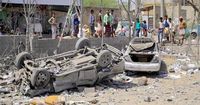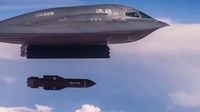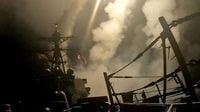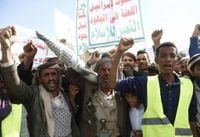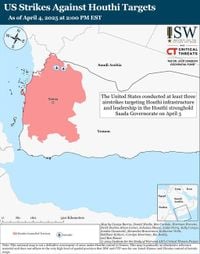In a significant escalation of military operations, the U.S. has deployed B-2 Spirit stealth bombers against Houthi targets in Yemen, marking a pivotal moment in its ongoing campaign against the Iran-backed militia. This operation, which commenced on March 15, 2025, has already cost nearly $1 billion in just three weeks, raising questions about its effectiveness and the strategic direction of U.S. military involvement in the region.
Stationed at the remote Diego Garcia base in the Indian Ocean, the B-2 bombers have targeted fortified underground weapon caches controlled by the Houthis, who have disrupted shipping in the Red Sea for months. The Pentagon's aim is clear: to degrade the Houthis’ capabilities to threaten international waters. However, reports suggest that despite the high-tech firepower employed, the impact of these strikes has been limited.
According to CNN, the operation has utilized hundreds of millions of dollars worth of munitions, including JASSM long-range cruise missiles, JSOWs, and Tomahawk missiles. Former Defense Secretary Lloyd Austin had previously confirmed a similar mission in October 2024, when B-2s targeted hardened weapons storage sites in Yemen. The current campaign reflects a shift towards a more aggressive military posture, with U.S. officials indicating that the strikes have eliminated several members of Houthi leadership and destroyed some military sites.
However, the Houthis have continued to fortify their underground bunkers and maintain weapons stockpiles, making it difficult for U.S. forces to assess the full extent of damage inflicted. "They’ve taken out some sites, but that hasn’t affected the Houthis’ ability to continue shooting at ships in the Red Sea or shooting down U.S. drones," one source briefed on the operation noted.
The Houthis, who seized control of Yemen's capital, Sanaa, in 2014, have demonstrated resilience against U.S. airstrikes. Their capability to target U.S. warships, including the aircraft carrier USS Harry S. Truman, using cruise missiles and drones, has raised concerns about the effectiveness of the U.S. campaign. Houthi military spokesman Yahya Saree claimed that they thwarted two planned U.S. aerial attacks on April 4, 2025, emphasizing their commitment to resisting U.S. aggression.
As the conflict escalates, civilian casualties have also mounted. The Houthi-run Health Ministry reported at least 61 civilian deaths and 139 injuries from U.S. airstrikes since the campaign began. Critics of the operation, including Vice President J.D. Vance, have labeled the offensive a “mistake,” questioning the rationale behind such high-cost military actions against a group that employs low-cost tactics.
President Donald Trump, who ordered the strikes, has claimed that the Houthis have been “decimated” by U.S. actions, yet Pentagon officials have privately acknowledged the limited success in dismantling the group’s extensive underground arsenal. The current military strategy, dubbed Operation Rough Rider, aims to exert pressure on the Houthis to cease their attacks on international shipping lanes.
The operational tempo of strikes has increased, allowing military commanders greater autonomy to conduct missions without higher-level approvals, a shift from the Biden administration's approach. This change has resulted in a more aggressive strategy, with reports indicating that the strikes could continue for up to six months.
Despite the heavy bombardment, the Houthis have shown an ability to adapt, reinforcing their positions and continuing missile attacks against commercial vessels in the Red Sea. The U.S. military's reliance on advanced munitions, while effective in achieving precision strikes, raises concerns about the long-term sustainability of such operations, particularly in light of the limited results thus far.
As the conflict unfolds, the implications extend beyond Yemen. The U.S. military's actions are viewed as a signal to Iran, which has heavily invested in supporting the Houthis as a proxy in the region. The B-2's ability to strike hardened targets serves as a potential warning to Iran regarding its own underground facilities, such as those at Natanz and Fordow.
Moreover, the operational costs and the potential drain on military resources have led to discussions within the Pentagon about the need for supplemental funding from Congress. As the U.S. expends vast quantities of precision munitions, there are concerns about the impact on military readiness in other regions, particularly in the Indo-Pacific, where tensions with China are rising.
In examining the broader context of the conflict, the Houthis have leveraged their underground infrastructure to maintain operational capabilities despite ongoing U.S. airstrikes. Their strategy mirrors tactics seen in other asymmetric conflicts, where low-tech solutions effectively counter high-tech military power.
The ongoing air campaign against the Houthis reflects a complex interplay of military strategy, geopolitical considerations, and the realities of modern warfare. With the B-2 Spirit bombers leading the charge, the U.S. aims to project power and deter threats in the region. However, the persistent nature of the Houthi threat and the limited success of airstrikes highlight the challenges of achieving lasting stability in Yemen.
As the situation continues to evolve, the lessons learned from this operation may shape future U.S. military engagements, particularly as new technologies and strategies emerge. The development of the B-21 Raider, the B-2’s successor, promises to address some of the operational limitations faced by its predecessor, but the current campaign serves as a sobering reminder of the complexities involved in modern military conflict.
In the end, the B-2’s deployment from Diego Garcia underscores a broader narrative of U.S. military power, yet it also raises critical questions about the efficacy of airpower in a landscape where adversaries can adapt and withstand even the most advanced military capabilities.
